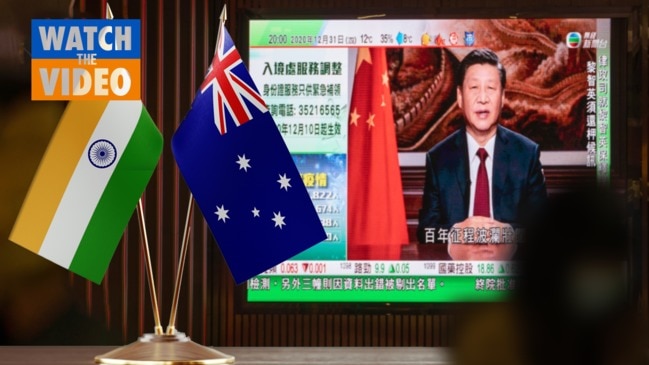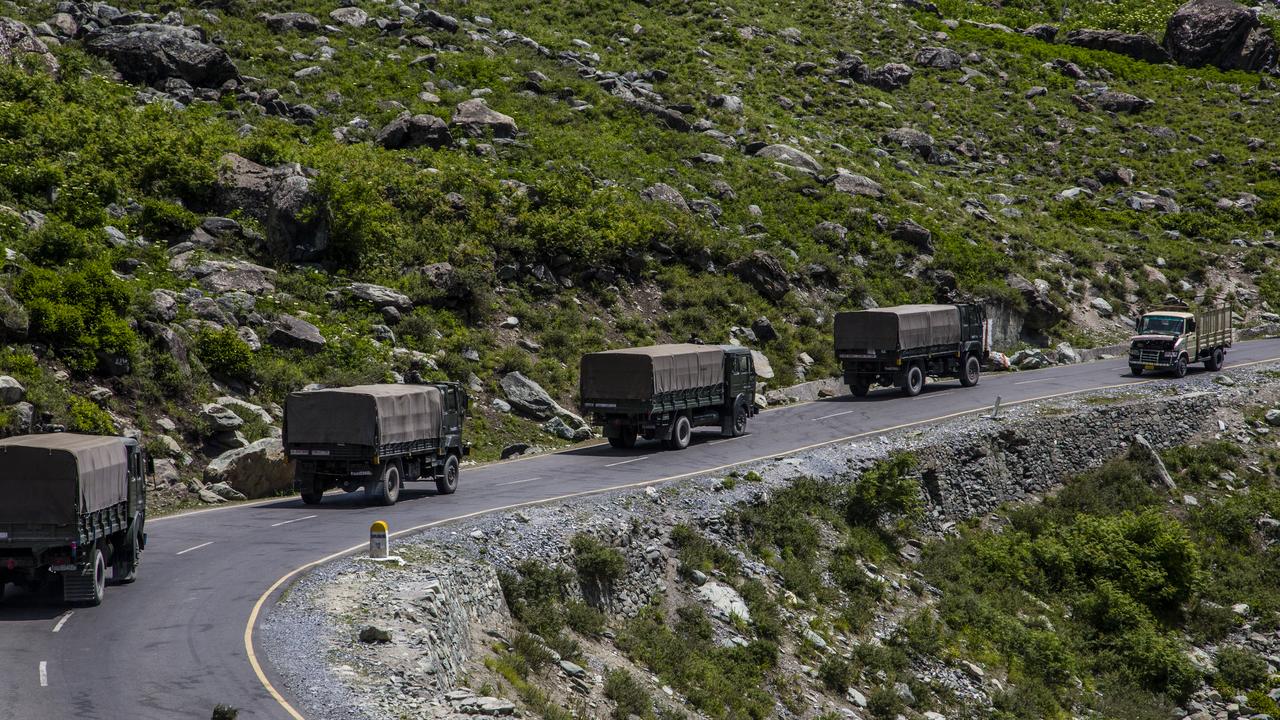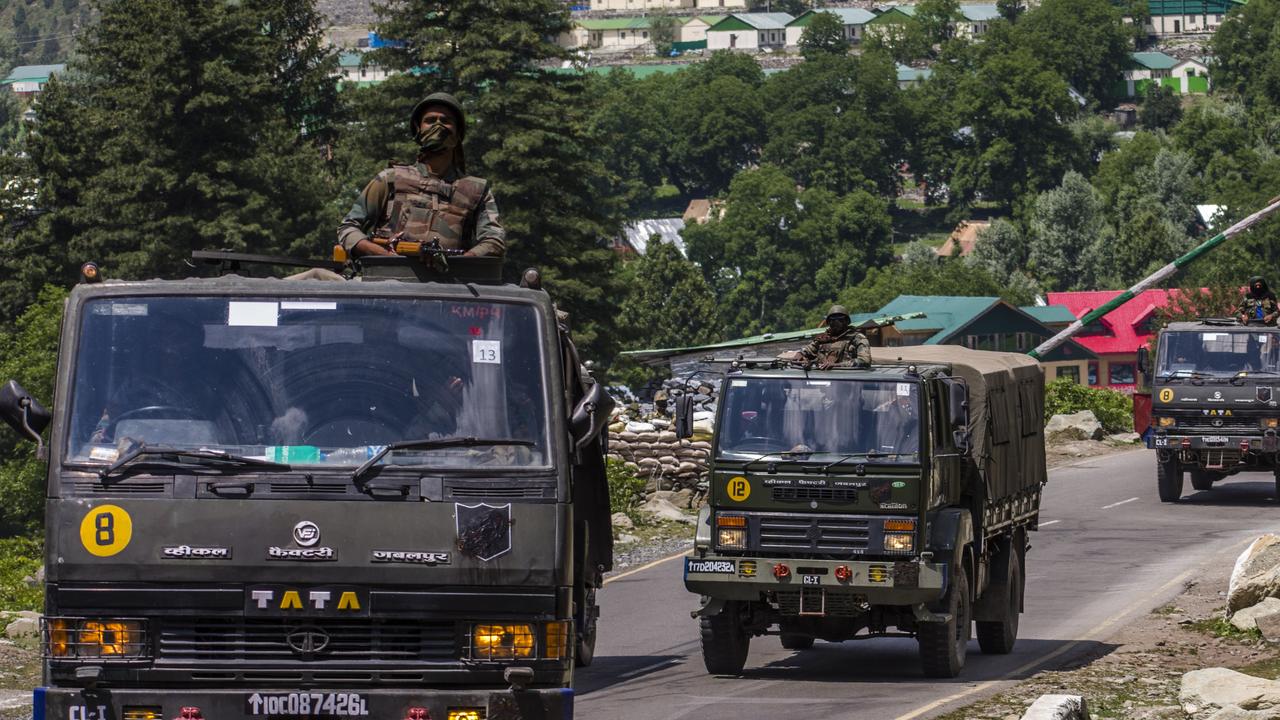India China tensions rise as 50,000 troops rush to protect border
While the world’s attention was elsewhere, China has been expanding and building new bases. Now 50,000 troops have been deployed.

China’s military activity around Taiwan has drawn the world’s attention. But Beijing has also been busy elsewhere. Which is why India is rushing to reinforce its northern borders.
A bloody brawl erupted in the Himalayan high plateaus a year ago, in which more than 20 Indian and Chinese border troops were killed.
Beijing had been pushing the limits of decades-old territorial agreements.
New Delhi dug in its heels – but only after losing some 300sq km of mountain terrain.
The two have been engaged in a frosty standoff ever since.
No further fighting has so far occurred between the nuclear-armed neighbours.
But tensions remain high.
RELATED: China ‘doubles down’ in troubled sea
A Rezang-La image from Jan-2021 puts into perspective how close #India & #China were during the standoff, tanks sitting a couple of feet apart as tensions peaked a month before de-escalation in the sector pic.twitter.com/fhbc7MNf07
— d-atisâ˜ ï¸ (@detresfa_) June 26, 2021
In the past year, India has repositioned some 50,000 troops along its Himalayan borders. Combat aircraft squadrons have been moved to northern bases. Tanks have been redeployed.
It’s been in response to China’s ongoing massive military build-up.
Almost 12 months after high-level military talks produced an agreement for a simultaneous withdrawal, neither side has backed down.
RELATED: ‘We can bomb’: Tense standoff at sea

“That accord reduced the immediate risk of an armed confrontation, but tensions remain high, and warning indicators for conflict continue to blink red,” Professor Daniel Markey of the John Hopkins School of Advanced International Relations said. “Both sides remain fully committed to military strategies and tactics that will bring heavily armed forces into closer and deadlier contact.”
India digs in
A brief battle in 1962 set the scene for the simmering tensions. Communist China – which invaded Tibet in 1949 – wanted to push its borders to the southern side of the Himalayas from where it could observe a broad expanse of India’s lowlands.
New Delhi has accepted Beijing’s annexation of neighbouring Tibet. But it won’t accept attempts to redraw its borders.
Which is why about 20 of its troops died after a brutal fistfight on the banks of the freezing, thin-aired Pangong Tso glacial lake in June last year. China has never openly admitted the full extent of its own casualties.
Located roughly 100 Km from the #India#Pakistan border in #Rajasthan, upgrades to the #IndianAirForce Station Phalodi are visible on recent imagery, new aircraft shelters being constructed since 2019 aim to increase the operational capability of the station. pic.twitter.com/iPw4gOgi98
— d-atisâ˜ ï¸ (@detresfa_) June 22, 2021
Reinforcing such troops is a tricky business.
It takes up to six weeks to acclimatise the human body to the combination of cold and low atmospheric pressure. Simply rushing troops up to the mountain plateaus could kill them.
Military analysts say India now has a total of 200,000 troops mobilised to maintain the border’s status quo.
Professor Markey says many of these have been redeployed from India’s tense Kashmir region on the border with Pakistan. Some 20,000 new troops appear to have been sent to reinforce Ladakh. Another 30,000 have moved to the eastern state of Arunachal Pradesh. These have been positioned between Bhutan and Myanmar and on the four-way border junction with Bangladesh.
New Delhi’s ageing air force has begun to receive new French-built Rafale fighter jets. These are being sent straight to the front line as they arrive.
China mobilises
Satellite images have captured the extent of Beijing’s massive new efforts to expand and build new bases, establish ammunition dumps, deploy tanks and artillery and cut new roads to the Himalayan highlands.
It has also begun rotating out its older generation combat aircraft. Modern J-16 strike fighters and the stealthy J-20 have been spotted on nearby runways in Tibet and Xinjiang.
Indian media last month quoted military intelligence sources as reporting Beijing had been testing its secret new H-20 strategic stealth bomber high above the Himalayas.
But, most provocatively, Beijing has been establishing illegal settlements outside its territory. Satellite photos and Communist Party propaganda reveal whole towns being built inside Bhutan, close to its border junction with China and India.
Continued research of PLA developments in #Tibet, #China uncover another suspected underground facility (UGF) under construction since 2019, the unit is located near a large military logistics hub & is south of an existing UGF in Shannan pic.twitter.com/ydskdZ8zNj
— d-atisâ˜ ï¸ (@detresfa_) June 7, 2021
Meanwhile, Beijing has conducted more than 100 military exercises along the disputed border in the past six months.
At the weekend, the Hong Kong-based South China Morning Post (now subject to Beijing’s controlling national security laws) reported the People’s Liberation Army as saying it had completed a “record-breaking” high-altitude drill involving more than 1000 troops.
Beijing Defence Ministry spokesman Ren Guoqiang reportedly said the drone-centred operation was “aimed at boosting the border troops’ combat capabilities in an extremely cold, tough and risky environment”.
It also claims India has trained some 10,000 exiled Tibetans to “pose as local herdsmen” to “infiltrate” China’s borders.
Another Cold War
Mutual suspicion and political posturing is a recipe for disaster, said Professor Markey.
“The political and strategic stakes associated with backing down or appearing weak in any single dispute, and overlapping crises would complicate the mechanics of timely intelligence gathering, decision-making, and signalling required to avoid violence,” he said.
The Galwan Valley clash set New Delhi and Beijing down a path of economic coercion and diplomatic posturing.

India immediately began strengthening its relationships with regional powers through the Quad (involving the US, Japan and Australia).
It sent a warship into the South China Sea as a demonstration of “Freedom of Navigation”. Beijing has said it has total control over the waterway. In 2015, the UN rejected that claim.
It banned a host of Chinese-made software and web apps, including social media services WeChat and TikTok. It cited security risks in doing so.
It also blocked Communist Party-controlled Chinese companies from critical national projects.
Beijing retaliated.
It imposed its own economic and diplomatic countermeasures.
But it is also believed to have been behind a cyber attack that brought down the power grid in India’s largest city, Mumbai, in October.
“Those signals indicate how future crises could spill over into other areas and exacerbate rather than calm a crisis,” Professor Markey said. “Looking ahead, the likelihood of persistent China-India tensions and simultaneous disputes remains high. Along their land border, the jockeying for tactical advantage will continue even assuming they abide by the painfully negotiated terms of their recent disengagement deal.”
Jamie Seidel is a freelance writer | @JamieSeidel




